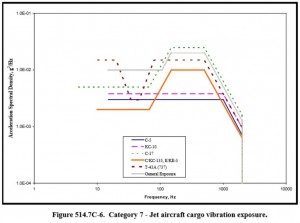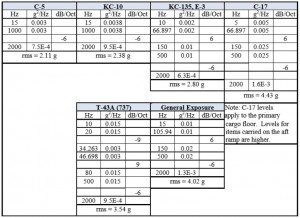This is part three of a series of blog posts concerning the MIL-STD 810 Vibration Section. This blog was written with reference to MIL-STD-810G w/Change 1 dated 15 April 2014. DES has the experience and expertise to help you determine what profiles are appropriate for your product and to run your MIL-STD-810 vibration test. For more information, please check out our Vibration Testing services page and our other MIL-STD-810 vibration testing blog articles:
MIL-STD-810 Vibration Testing Overview
MIL-STD-810: Vibration Testing Category 4 – Truck/Trailer – Secured Cargo
MIL-STD-810: Vibration Testing Category 9 – Aircraft – Helicopter
Category 7 of Method 514.7 Vibration testing simulates vibration conditions of cargo in jet aircraft. These vibrations are broadband random. Typically the maximum vibration levels produced are caused by the exhaust noise generated during takeoff. Vibration during normal flight is substantially less. Figure 1 and Table 1 detail the Acceleration Spectral Density (ASD) and frequency levels of various aircrafts and the vibration exposure of cargo carried on those respective aircrafts during takeoff. The General Exposure curve can be used when the specific aircraft is no known.
The test duration is 1 minute per takeoff times the number of takeoffs the product may see in its lifetime.


To learn more about our vibration testing services, please feel free to contact us with your inquiry. Feel free to explore our site to learn about our full line of product testing services, and the test standards that we can help our clients with.